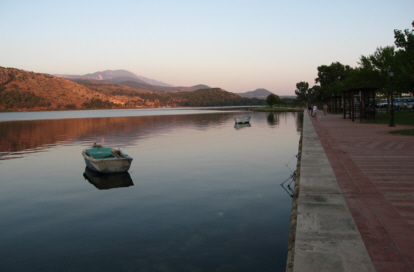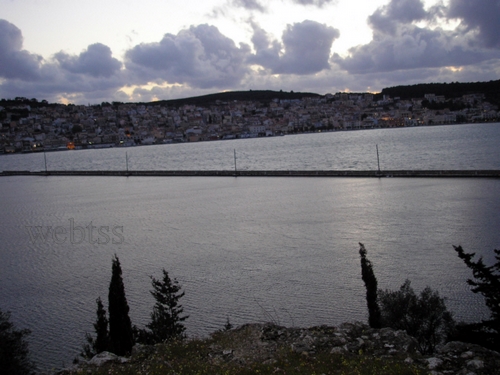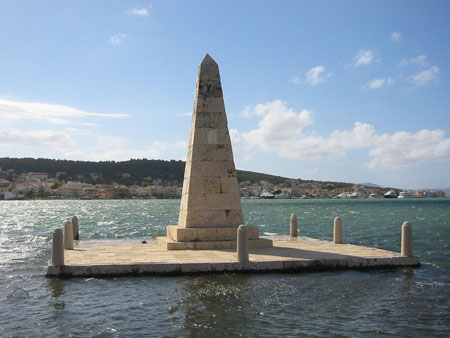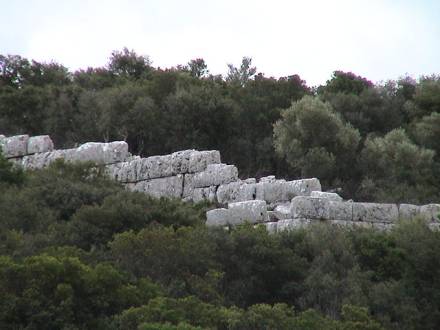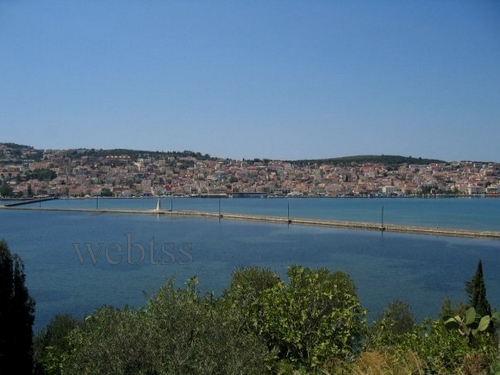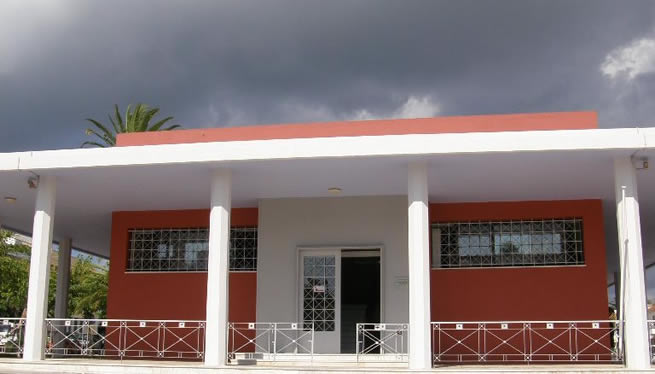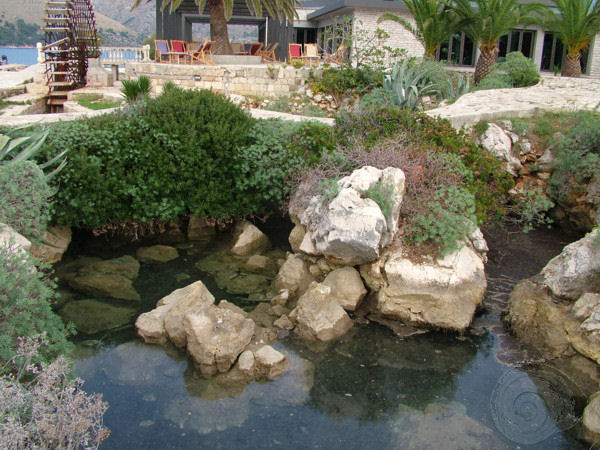 Kefalonia Guide
Kefalonia Guide  Argostoli
Argostoli
Welcome to
the Kefalonia Travel Guide.
It is a fully updated guide to all matters relating to this beautiful island Kefalonia in
the Ionian
Sea. Find information about the history of the island and about all the
areas of interest for the tourist
Argostoli
Argostoli has been the capital of the island since 1757. It is amphitheatrically built around the Koutavos lagoon and is a relatively young town being almost totally rebuilt from scratch after the earthquake in 1953. The town has many tourist attractions and sights for the visitors, including museums, monuments and natural geological phenomena to name a few.
Places that we highly recommend for you to visit:
Maritime Museum
The village of Farsa houses the Maritime Museum, a part of the municipality of Argostoli. It was founded in 1997 to report the relationship between man and the sea. Among the exhibits at the museum are ship models, prints, maps, tables, nautical instruments, books, part of ships, etc. It is a remarkable effort allowing the visitor to learn about the island and that shipping is one of the most important elements of its maritime character.
Natural History Museum
The Natural History Museum of Kefalonia and Ithaca is located in the village of Davgata, 5km away from Argostoli, here the visitor is able to discover the natural beauty of flora and fauna and the marine environment of the two islands. Also from the geological phenomena of the island and the National Park of Mount Ainos that has a particular type of vegetation. The Museum was founded in 1996 by the Society for the Protection of Nature for Kefalonia and Ithaca in cooperation with the former Davgaton Community and Cultural Association and it received an award in 2001 from the Academy of Athens. The aim of the museum is to inform people of the multifaceted natural wealth of the islands, to alert visitors about issues concerning the environment and urge them to protect it.
Cyclopean Walls
Three kilometres away from Argostoli are the ruins of the ancient Krania walls dating as far back as the 6th or 7th centuary BC. Today the ruins survive, 4km in perimeter and are known as the Cyclopean walls because of their enormous size. The type of rock used to build the walls indicates its date and gives information about Krani. Here amongst the debris a Doric temple dedicated to the goddess Demeter and her daughter Persephone was found, an inscription was found on one of the rocks, which is kept at the Archaeological Museum. The inscription reads ‘Triopis Damatria and Kora’, which means Triopida is devoted to Demeter and her daughter. The south side of the hill, called "Root" operated as an ancient necropolis of tombs found in Krania before the mycenean period.
Anthony Tritsi Avenue
The avenue that crosses the entire port of Argostoli is named after the Kefalonian
politician, Anthony Tritsi whose statue is located at the entrance to the town,
near the gymnasium.Stores of all kinds can be encountered as
you cross the road from the sea front. Starting from the Port, running along the
sea front the pavement is paved with beautiful black and white pebbles creating
a wonderful design, palm trees and benches complement the scene.
Debosset Bridge
Just as you enter the town you will find the ‘Devosetou’ bridge named in honour of the Swiss engineer Philip Charles-De Bosset. The English army officer and governor of Kefalonia inspired the construction in 1813 and it was the British who built it.The purpose was to prevent entry into Argostoli from the Koutavos, because in the old days the area was synonymous with malaria and death. It is the largest stone bridge over the sea with a length of 900 meters. Initially, it was built from wood. But due to the passage of people and animals after the levelling of the hill, ‘Metela’, the bridge was rebuilt in stone.It was first built with arches every 4 meters and was completed after three years. At the end of the project ‘De Bosset’ proposed building a monument in honour of the nation, and so a marble obelisk was constructed in the middle of the bridge, symbolizing the gratitude of the House of Kefalonian in Great Britain.Across the other side of the bridge from Argostoli lie the English and Italian cemeteries and the Greek Cemetery of the Monastery of ‘Drapanos’. It was renovated by Napier between 1822-1830. But during the Italian and German domination it suffered a lot of damage from the bombings but still remained intact. The earthquake of 1953 also caused damage sinking a large part of it and leaving several cracks, but nevertheless it continues to stand resplendent today.In 1970 it was declared a monument preserved and protected by international authorities. Today, due to further damages and sinking cars are no longer allowed to pass over it, but the pavement is still suitable for walking on and especially at night it offers an idyllic atmosphere.
Lithostroto
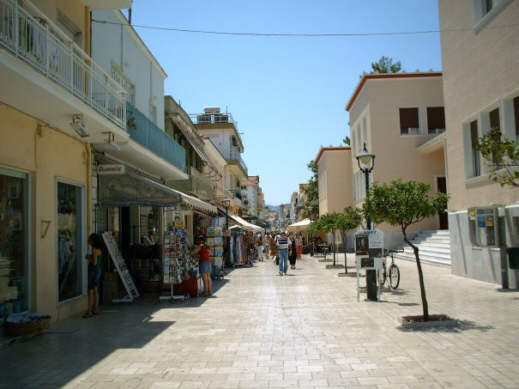 The Lithostroto is the main shopping street
of the town with many commercial shops stretching along both sides of the street
for about 4 meters. Before the 1953 earthquake it was, in length, about one
thousand steps paved with blocks of white, which is from where it took its name,
which remains the same today.The street starts from the a small square in
the town, historically known as San Marco Square and then later as Freedom
Square due to the advent of the democratic local French in 1757, who burnt the ‘Libro d'oro’ namely the Book of the nobles thus
eliminating class differences. In 1770-1790 a square tower was built by the
square with a large bell to give the time and thus
providing the square with its name. Apart from marking the time it was used as a
fire alarm and also to celebrate national anniversaries. On the ground
floor of the Tower gendarmeries worked adding two lower wings. In the
earthquake of 1953 the tower was destroyed and was rebuilt in its present
form.
The Lithostroto is the main shopping street
of the town with many commercial shops stretching along both sides of the street
for about 4 meters. Before the 1953 earthquake it was, in length, about one
thousand steps paved with blocks of white, which is from where it took its name,
which remains the same today.The street starts from the a small square in
the town, historically known as San Marco Square and then later as Freedom
Square due to the advent of the democratic local French in 1757, who burnt the ‘Libro d'oro’ namely the Book of the nobles thus
eliminating class differences. In 1770-1790 a square tower was built by the
square with a large bell to give the time and thus
providing the square with its name. Apart from marking the time it was used as a
fire alarm and also to celebrate national anniversaries. On the ground
floor of the Tower gendarmeries worked adding two lower wings. In the
earthquake of 1953 the tower was destroyed and was rebuilt in its present
form.
Archealogical Museum
At the end of Lithostroto is the Archaeological Museum which was founded in 1957 and it replaced the old museum in 1960, which was destroyed by the earthquake of 1953. The earthquake caused great damage to the building and several findings from the first excavations of P. Kavvadias and the archaeologist Marinatos Sp were lost. After consecutive earthquakes in the region the museum underwent major repairs which began in 1998 and were finally completed in 2002 by the Ministry of Culture. The Museum has three rooms dating from the Paleolithic period to the isteroroman. In the first room of the Paleolithic period, tools found in Sami, Fiskardo and Skala and utensils of the Middle period from the tombs in Kokolata can be seen. In room 2 you will see findings from the Mycenaean period, which came from graves discovered across the island and in Room 3 are findings related to the Tetrapolis, the four states, the way that the island was divided during the 5th centur. Also objects from the Roman cemeteries in Fiskardo are housed in the museum
Korgialenios Library-Culture Museum
Along the street is the Korgialenios library and the Culture Museum. Founded in 1924, it houses over 6000 volumes which list most of the material includin the days before the earthquake. There are several manuscripts and rare editions such as the ‘Dictionary of Souida’ the oldest existing Encyclopaedia that is thought to be a couple of thousand years old, made with ancient and medieval material.
The ground floor is the Culture Museum, which was founded in 1962 by Helen M. Kosmetatou and it began operating in 1966 with some money given by Evaggelos Bassias. The purpose of the museum was to preserve the memory of Kefalonia before the devastating earthquake of 1953 and it houses material from the early 15th century up until 1848. Culture elements such as china, silverware, embroidery, Kefalonian art, lithographs, utensils, sculptures, tools, coins and some 3,000 photographs, and an old style bedroom, set out with the hope of sending the visitor to live briefly in a time with a strong culture.
Vallianos Square
The main central square of Argostoli is called ‘Vallianou square’. Named after a benefactor of Kefalonia Panagi Vallianos, a statue of who is located in the square. In the avenue before the square is the Fokas-Kosmetato house. Built in 1984 by bequest of the brothers Spyros and Nicholas Kosmetato. This preserved house was rebuilt after the earthquake of 1953 and was transformed into a museum and art gallery to house their personal collections. Inside the visitor will find lithographs and Ionian Greek Interests, French 18th century coins and banknotes from the Mediterranean area.
Just passed the square along the avenue of the road with the phoinix is another house of Kosmetatos. It is one of the few buildings that still stand, after surviving the earthquake of 1953. The once two-storey house is now just one floor, it was damaged internally but several of the paintings that adorn the ceiling and the walls survived
Napier's Garden
Above Vallianou Square is the famous garden of Napier. It stands apart from the other gardens because it is elevated and has a large variety of trees. History of the 19th century in Argostoli depicts that it was a vineyard. The British governor of Kefalonia at this time, Colonel Sir Charles James Napier purchased it in 1828.In November of 1905 it stood as a Municipal grove with a kiosk in the centre and it was used as a recreational area and for entertainment. In the following years a bust of Napier was constructed by the sculptor John Red and on the base was an inscription. After the earthquake the garden was finally abandoned until the 2003-2004 period where the regeneration funding from the Third Community Support Framework was used to return the garden to its original form, it was planted with many flowers and a kiosk was in the spot of the original one that existed. T the beginning of the 2004 Olympics the Olympic Flame ceremony took place in the garden of Napier.
Nikos Kavvadias
Nikos Kavvadias is one of the most famous personalities of the island and one of the most beloved poets in Greece. He wrote many poems, many of which were singed by famous singers. At the end of the port of Argostoli is the statue of Nikos Kavvadios, erected as a tribute to this important man who came from the beautiful island and specifically from Fiskardo.
Italian Monument
Starting from the Villainous square, through Rizospaston road, the pathtowards Lassi on top of the hill is a monument that reflects the
recent history of Kefalonia. This is the monument built in honour of the
Italians who were executed by Germans towards the end of the 2nd world war. The Italians had arrived in 1941 to occupy the island after the
collapse of the Greek front. The Italians were executed after the fall of
Italy to the allied forces. The
Germans promised that they could return home unharmed, but instead they rounded
up all the troops that were stationed on the islands and shot them all, killing
over 10,000 men on Kefalonia and Ithaca alone. Today the monument dominates
reminiscent to the old and young of how many may suffer due to war.
Katavothres
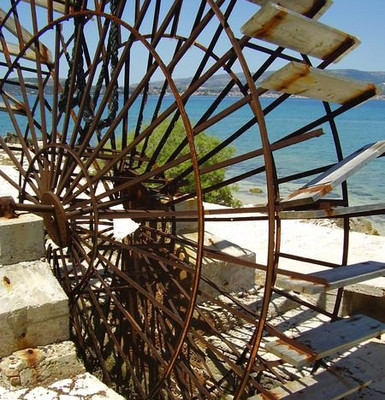 Along the back road that runs from Argostoli to Lassi you will find a rare
geological phenomenon, known as "Katavothres", in which rain water enters
an underground tunnel near the shore and disappears under the island. The tunnel
then passes beneath the island and arrives after some days on the other side of
the island, in Melissani Lake and then in the village of Karavomilos, where it rejoins the sea.
The phenomenon was first observed by an
Englishman called Stewens, who was impressed by the mills located at each end.
At the same time a famous geologist ‘Miliaresis’ studied the effects of
earthquakes to this phenomenon. Studies after earthquakes and especially after
the great earthquake of 1953 observed that there was no change in the flow of
the water and the mills continued to operate flawlessly. During the Second World War the mills were
used in the workings of ice factories.The phenomenon was verified in 1963 by an
Austrian geologist. A quantity of coloured ink was cast into one of the sinks
and its journey was tracked showing that the water moves northwest under the
island and having united with the rainwater comes out in Melissani Lake and then
continues on to a circular lake in Karavomilos, a village near to
Sami.
Along the back road that runs from Argostoli to Lassi you will find a rare
geological phenomenon, known as "Katavothres", in which rain water enters
an underground tunnel near the shore and disappears under the island. The tunnel
then passes beneath the island and arrives after some days on the other side of
the island, in Melissani Lake and then in the village of Karavomilos, where it rejoins the sea.
The phenomenon was first observed by an
Englishman called Stewens, who was impressed by the mills located at each end.
At the same time a famous geologist ‘Miliaresis’ studied the effects of
earthquakes to this phenomenon. Studies after earthquakes and especially after
the great earthquake of 1953 observed that there was no change in the flow of
the water and the mills continued to operate flawlessly. During the Second World War the mills were
used in the workings of ice factories.The phenomenon was verified in 1963 by an
Austrian geologist. A quantity of coloured ink was cast into one of the sinks
and its journey was tracked showing that the water moves northwest under the
island and having united with the rainwater comes out in Melissani Lake and then
continues on to a circular lake in Karavomilos, a village near to
Sami.
